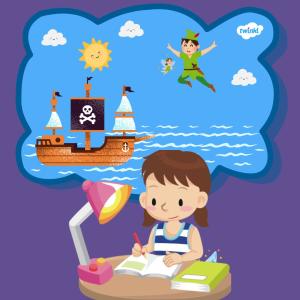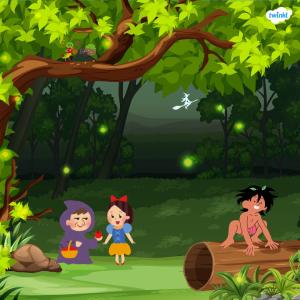A Guest blog on encouraging our younger children to find passion in storytelling by our friends at Twinkl

For as long as Shakespeare’s plays have been in the public domain, there have been stories based on them. Take Gnomeo and Juliet, for instance, which is a modern take on the play about two ill-fated lovers. It’s aimed at children and is a great way to introduce them to Shakespeare's work. So, if you’re wondering about the question: Gnomeo and Juliet is based on which Shakespeare play? Read on because the answer will appear at some point! The Bard’s plays focus on themes that are still relevant today, some of which children may touch on when telling their own stories. This could include stories about friendship, making difficult choices or reconciliation. The possibilities are endless! This summer, Shakespeare's England are asking you to 'Write Your Own Story in Shakespeare’s England' so here are some tips to encourage young minds to love making stories.

Why encourage children to love making stories?
Before we get on to the what and how, let’s have a look at the benefits of storytelling and story writing. They develop a range of skills, including their:
- imagination
- curiosity and creativity
- vocabulary and writing
- communication skills and memory
- emotional awareness and social skills
- confidence and speaking
- concentration and focus
- understanding of the world around them, including different cultures
Fostering a love for making stories often means children will enjoy telling stories, too. This is a fantastic opportunity to spend uninterrupted time together, whether it’s part of a bedtime routine or if you’re out on a walk, especially if you establish a regular routine. This could even include weekly reading sessions with small groups of your class in a dedicated reading corner. Being able to talk about things can help children make sense of what may be going on in their lives or friendship groups.

What makes a great story?
A beginning, middle and end, which takes the audience from start to finish, undoubtedly helps to make a great story. But writing a story is so much more than that. For instance, Shakespeare’s plots were about universal themes, such as love, friendship, happiness and sadness - I could go on. The thing is, we can all relate to the themes he used. This is one aspect that draws us into his writing. If children write about things they know or imagine, they’re giving us a unique insight into how they understand the world around them, which is priceless. Characters are often what keeps a plot moving, so it’s always worth helping children think about what each one brings to their story. Shakespeare’s characters are full of depth. He took time to explore their emotions and motives. Some of them conveyed the darkness of his writing, like Iago in Othello, whereas others were more light-hearted, such as Polonius from Hamlet. Let’s have a look at what else children should include when thinking about how to start writing a story.

How to start writing a story
There are many things that come to mind when thinking about what makes a great story, including these five elements of story writing.
Characters
Who or what takes part in the story? Is there a protagonist (main character) and antagonist (character in conflict with the main character).
Setting
Where’s the location of the story? Don’t forget to describe it, so the audience can imagine where the story or different scenes takes place. Appeal to the senses, such as smells, sights and sounds to draw them in.
Plot
Have you thought about the beginning (introduction), middle (main body) and ending (conclusion) of your story? Feature any events or actions that are important to each part, such as a climactic point, problem(s) and resolution.
Conflict
This could be a disagreement or struggle between the characters, often with the main one(s) being involved in some way. This conflict tends to be resolved by the end of your story.
Theme
Is there a message or purpose to your story being told? For example, is there a moral to your story or something you want your audience to learn as it unfolds?

Tell your story!
Set the Stage
If a child has written a story, why not give them a platform to tell it? It doesn’t have to be as elaborate as a stage but somewhere without any distractions. This is an effective way for them to gain confidence in public speaking and reading, amongst other things. Perhaps encourage them to use different voices or objects for their characters to add a different element to their storytelling.
Q and A
Ask them questions. Doing this shows that you were listening, engaged, and gets them to think about what they’ve written.
Make your voice heard
Now it’s time to turn the tables and let them hear you tell your story you’ve written. It exposes them to vocabulary they might be unfamiliar with and gives them an opportunity to ask questions about what you’ve written.

Bravo! Brava!
Lastly, don’t forget to applaud their endeavours! Praise and encouragement provides children with the confidence to continue to develop their storytelling skills, along with all the others that go hand in hand with this activity.
Telling stories can be done anytime and anywhere! This could include Monday mornings, when you ask your class what they did over the weekend, or when you ask your child how their day was. By recounting events, they’re telling a story.
When you tell your friends about what’s happened at work, you’re doing the same. We tell stories all the time. It’s an innate part of being human.
Let’s not forget that telling stories is also so much fun! Perhaps that’s why Shakespeare wrote so many of them. He must’ve enjoyed creating them, just like so many others before and after him. Many of his plays have been rewritten to be apt for the time, which brings me to the question: Gnomeo and Juliet is based on which Shakespeare play?
It’s Romeo and Juliet. Aside from the many lifelong transferable skills, if children learn to love making stories, they continue this rich tapestry of tales. You never know, Write Your Own Story in Shakespeare’s England could shine a light on the next author of our time!

About the Author
Elaine Daniels works as a Content Executive for Twinkl, an online educational resource publisher. Armed with a degree in language and education, along with her PTLLS and CELTA, she spent many years teaching ESOL within her local community. Just before settling down at Twinkl, she was a freelance writer, writing about many topics, but mainly specialising in academia, well-being, and finance.
A self-confessed nerd, Elaine enjoys reading, writing and crocheting. In her spare time, she's trying to convince Mika, her cat, that she really is a cat and not a dog. Elaine's available for collaborations or guest posts. Reach out to her via elaine.daniels@twinkl.co.uk if you're interested.
